Warm baseboard: what are baseboard heating radiators and how to install them correctly
An unusual heating technology, fundamentally different from the usual systems with radiators under the windows, has come to us from European countries recently, although it has been used there for more than twenty years. The name of the innovation speaks for itself - a warm baseboard, the demand for it is growing due to technical advantages and modern design.
You will learn all about the varieties of baseboard heating and the features of its operation by reading our article. We will talk about the design specifics and the rules for the construction of all types of baseboard heating systems. Here you will find out where the heating baseboard is used, which models are popular among consumers.
The content of the article:
The principle of the plinth heating device
A skirting heater is a heater 140 mm high and 30 mm thick, which is placed along the walls above the floor around the perimeter of the room.
Imagine that the large heating radiator, known to all of us, was reduced and stretched - a simplified design can be described just like that.
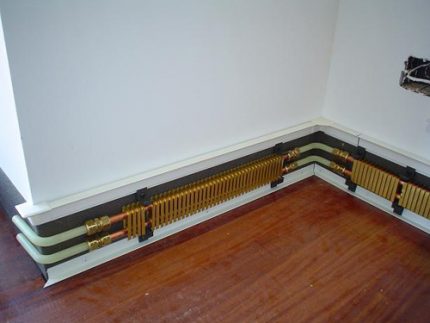
Materials for production are used the most thermally conductive and, accordingly, expensive - aluminum, copper, brass. Externally, the thermoplint is an aluminum box, a heating element is placed inside it - two copper tubes with brass, copper or aluminum plates (lamellas) strung on them.
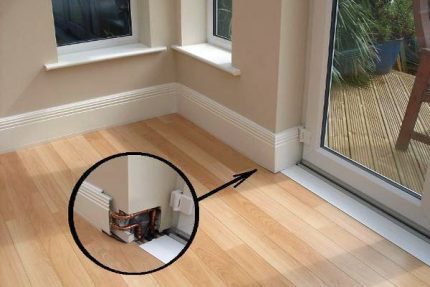
Depending on the coolant, there are liquid and electric warm skirtings:
- in liquids, water or antifreeze circulates, 0.34 liters of liquid falls per 1 linear meter, the temperature range is from 50 to 85 ° C, the temperature is set manually on the collector or automatically;
- in electric heaters are connected in parallel, their work is regulated by a temperature regulator with an integrated temperature sensor that determines the degree of heating of the air in the room.
The heating modules are mounted on the rear aluminum plate, which is attached to the wall directly above the floor. Outside, the structure is closed by a front plate - also of aluminum.
The coolant is supplied from the distribution manifold. The distribution manifold is equipped with flow meters, taps (drain, shut-off), automatic air vents, thermometers, pressure gauges - all this is necessary to control and adjust the heating system. Safe heating of the plinth surface is 40 ° С, maximum - 80 ° С, the air in the room warms up to 20-24 ° С.
Slots are provided in the lower and upper parts. The cold air stream enters from below into the body, heats up there, passing between the hot plates, and again goes outside, but through the upper slot.

Manufacturers of baseboard heating equipment claim heat transfer within 200 W per 1 meter of length, but in order to achieve this indicator in a liquid system, the temperature of the coolant must be raised to 65 ºС, and such a heating of the front panel cannot be called safe.
Features of baseboard heating
Heating from the moment of its invention to the present day is divided into two types - convection and panel-radiating. In the first case, the air is heated first from the hot surface of the heater (radiator battery, convector), after which it circulates in the room and gradually heats it.
In the second case, objects are initially heated in the room, and air is heated from them by useful infrared radiation that does not dry the air, does not corrode oxygen from it, and this process is secondary.
Among old examples are stoves in village houses, tiled stoves in old mansions, in the modern interpretation - heated floors, but what about plinth heating and what type of heating can it be attributed to?
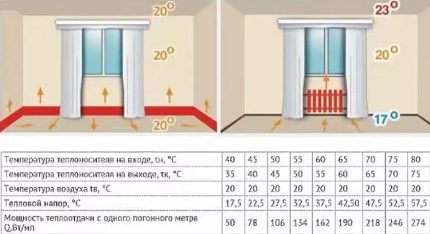
Let us turn again to the opinion of manufacturers. They unanimously say that the radiated heat along the perimeter rises from the floor to the ceiling along the walls, warms them evenly and creates a kind of curtain from the cold penetrating from the outside. Having warmed up enough, they themselves begin to give off heat.
In fact, the temperature of the walls at different heights varies in the range of 26-30 ºС, and in order for heat transfer from them, the surface must be heated much more. Consequently, talking about the coveted infrared heat coming from the walls is not so much true as a marketing ploy.
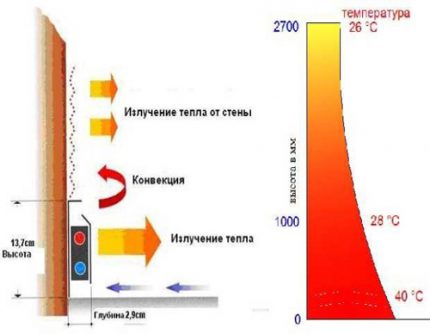
It is more correct to say that thermal skirting boards are also convectors with a high surface temperature. It’s just that the room warms up more evenly from the warm air currents, both directly emanating into the interior of the room, and so ascending along the walls. Warmed walls are a guarantee that you will not find dampness or mold anywhere on them.
It is also fair to note that as you move up, the amount of heat decreases, which is good. It is evenly distributed indoors in the lower and middle zones, to a lesser extent reaching the ceiling. For people, such a microclimate is considered the most comfortable - they do not freeze or chill, but at the same time breathe fresh and cool air.
Objectively about all the advantages and disadvantages
The ascending heat flux, according to the physical law of Coanda, is pressed against the wall. Without mixing with the rest of the air in the room, it heats the vertical surface. At a height of up to one and a half meters, the wall temperature is several degrees higher than in the room, and this creates thermal comfort for the people in it.
During the heating season, the heating system is activated for 6-8 hours daily. Multiplying the total capacity by the number of hours worked per month, we get the indicator of monthly energy consumption.
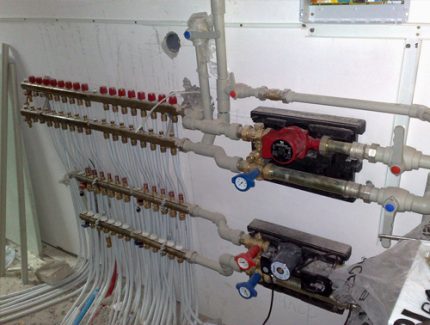
Do skirting heaters really save energy due to the low temperature of the coolant?
The answer would be an example:
- The area of the room is 3, 5 mx 5 m (17.5 sq. Meters), the perimeter is 17 m (minus the doorway - 16 m).
- The volume of the room with a ceiling height of 2.7 m: 17.5 * 2.7 = 47.25 cubic meters. meters
- Outdoor temperature in winter is -10 ºC on average.
- To maintain + 20-22ºC in a room with normal thermal insulation, 1.5 kW / h is required. Heating will work 7 hours a day.
Taking into account 200 W per 1 meter of length when heating the coolant to 65 ºС (see above) we get 200 W * 16 m = 3200 W or 3.2 kW. Since this flow rate is twice as high (3.2 kW / 1.5 kW = 2.1), it is possible to reduce the temperature of the coolant in the same proportion: 65 ºС / 2.1 = 31 ºС.
We calculate the monthly electricity consumption: 1.5 kW / h * 7 hours. * 30 days = 315 kW. More reliable results are obtained by a detailed thermal engineering calculation based on complete source data for the facility.
If we compare the effectiveness of the warm floor and skirting board, we can argue for the very reason that convectors from the floor immediately heat the air, and part of the warm air from the thermo skirting board is taken over by the external wall, which is constantly fed by cold from the outside.
The heat spent on constant heating of cold external walls is a kind of loss. Is their dryness, lack of mold, dampness a compensation for this? There is also a debate on this issue: some say yes, others indicate that the humidity in the room is regulatedsupply and exhaust ventilationrather than heating.
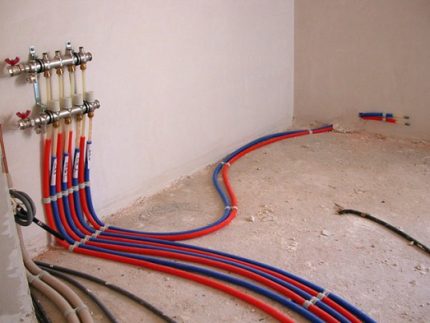
As for the appearance, the skirting boxes that cover the heating look really nice in the interior, but there are problems with cabinet furniture - you can't go around it in front, and behind it the warm air has no freedom of movement.
And about the absolute absence of dust in the air, it is worth arguing - it may be less than with air circulation in traditional heating systems, but it is, because convection is present.
In general, we can conclude that skirting radiators already have buyers, and over time their number will increase. The limiting factor is the excessively high cost of equipment, which is explained by the use of copper, brass, aluminum, i.e. expensive materials.
And installation, if ordered from professionals, is not cheap. Plinth layout of pipes is the most difficult of all available water heating circuits, but there are many nuances in the assembly of electric skirting boards.
Installation of a warm skirting board
For installation, you will need a tool: adjustable wrenches in a set, a drill with a shock function (or punch), a hammer, nippers, pliers, scissors (cut plastic). The plinth heating system is quickly mounted if the connection points are prepared in advance.
Before purchasing the necessary equipment, you need to plan what power do heating elements need and how to place them around the perimeter of the room.
Assembling a water heating system
Stage 1. We measure the distance from the point where it will be located distribution manifoldto the location of the baseboard. We cut off two lengths of the protective pipe and two with an allowance of 20 cm - the connecting one. We insert the connector into the protective one, cork the ends with adhesive tape to protect it from dirt.
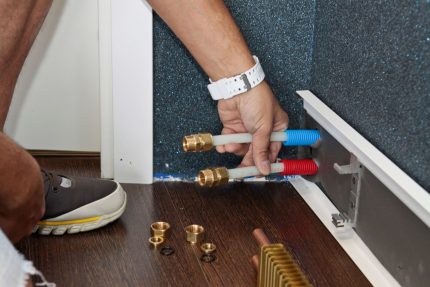
Stage 2. Pipes are pulled along the floor without tension so that, if necessary, building next to one another could be laid. We fix with mounting tapes, cover with a protective solution, protecting from damage, and put it in the right place on the wall 6 cm above the floor and 10-15 cm from the edge of the wall or corner, fix it with cement.
Stage 3. After laying the final floor, we continue to work. We stick an insulating strip along the entire length. We stretch the aluminum edge (also along the entire length of the heating), closing the junction of the wall and floor. Screw it on or fix it with duct tape, silicone.
Stage 4. We lay a special profile on the top line, we put holders on it at a distance of 15 cm from the corners and every 40 cm along the wall.
Stage 5. To connect the heating pipes and heating elements, we use couplings with nuts, bushings and gaskets, in the corners - angular swivel tubes 90º, in the ends - end swivel tubes 180º and plugs. Thermosections are interconnected by adapters.
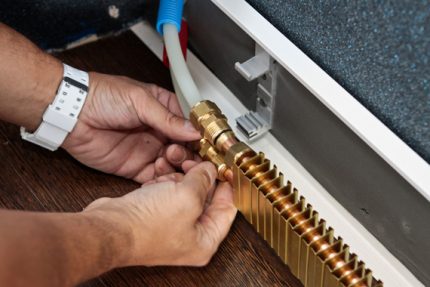
Stage 6. Carefully squeeze the connected heating sections into the holders. We put on decorative panels (fasten with screws or snap in) and decorative corner elements. We connect the system to the collector, fill the water, test at operating and maximum pressure.
Like all collector systems, heating skirting requires circulation pumpstimulating the movement of the coolant. Without a pump, heated water is difficult to circulate along an extended circuit. However, the use of technical devices affects the total cost of the system.
The skirting board will work if all technological operations were performed without violations. When leaking, problematic connections must be squeezed with a wrench.The coolant is supplied through the collector by a circulation pump from the boiler or from a common (centralized) heating system.
Assembly of an electric heating system
For a warm baseboard in an electrical panel, you need to make a separate circuit breaker. Its power is determined by the number of heating modules.
Stage 1. We bring power to the junction box, which should be next to the location of the system at a height of 4-6 cm from the floor.
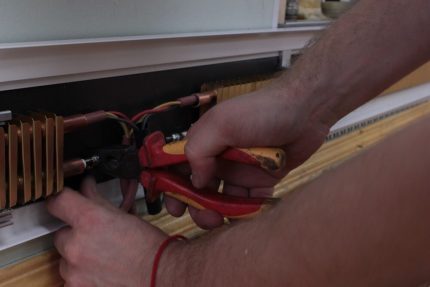
Stage 2. Glue the insulation tape on the wall.
Stage 3. We install the lower aluminum profile (edge) and the upper one on which we mount the holders at the same distance as for the water system - 15 cm from the corners and in increments of 40 cm along the wall. We mount an external temperature regulator. It should be at a height of about 1.5 m opposite the system modules and at a distance of at least 2 meters from them.
Stage 4. We insert electric heating elements (TENs) into the lower pipe of the heating module, fix the modules in the holders so that they do not touch the wall.
The electrical contacts of the heating elements are threaded, two nuts, a snap ring on the spring, a heat shrink tube for additional insulation. The modules are connected in parallel with a heat-resistant power cable with silicone coating and heat resistance up to 180 ° C.
Stage 5. We close the system with a plastic box on top.

It is better to entrust an electrician to the connection of the installed heating system to the power supply. He will check the reliability of the insulation with measuring instruments, supply electricity and adjust the thermostats.
Design, scope, price
Thin, graceful heaters, in harmony with the general atmosphere, allow you to realize the most non-standard design ideas.
The peculiarity of the plinth heating system is that it does not take away free space from the room at all, and it can be placed next to furniture, antiques, household appliances, musical instruments.
The material from which the flooring and walls are made also does not matter - there will be no damage and harm.
A palette of hundreds of colors and shades makes it possible to choose the appearance of the case to your liking. By texture, it can be a flat and smooth surface or imitation of granite stone, marble, wood.
The plinth radiator equalizes the temperature in the cooler corner and end rooms, the owners of cottages and country houses are interested in this technology, seeking to create an elegant interior in their homes. Yes, and in high-rise buildings, many people want to make heating of loggias, balconies, and this task is also easily solved with the help of a similar heating scheme.
Wherever plinth heating is used - in greenhouses and conservatories, pools and gyms, in museum buildings, concert halls, etc. Panoramic construction is in fashion, but along the wall, which is solid glass, conventional radiators do not put.
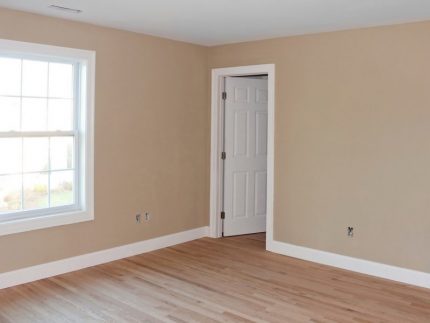
Traditional heating loses in rooms with high ceilings. No matter how much you heat them with batteries, warm air will still tend to rise up to the ceiling, leaving the lower zone cool, and with the help of a thermal baseboard, the situation can be easily fixed.
As for the price, the purchase and installation of a warm skirting board is comparable to the cost warm floors. Both that, and another will not manage cheaper than installation of a classical heating system with batteries.
Unfortunately, all energy-efficient devices cannot be called cheap, but the costs pay off. In order not to overpay the excess, you need to complete the system in advance - each of its elements has its own price. Only a specialist can do it competently.
Conclusions and useful video on the topic
Video # 1. How does a warm skirting board work:
Video # 2. Installation of baseboard heating system:
To summarize: a warm baseboard is a new, aesthetic and reliable type of heating equipment that deserves attention.
Want to talk about how you assembled and mounted a skirting radiator? Do you want to share your impressions of the operation of baseboard heating or ask a question? Please write comments in the block below.

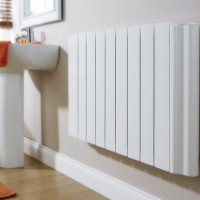 Vacuum heating radiators: overview of types, selection rules + installation technology
Vacuum heating radiators: overview of types, selection rules + installation technology 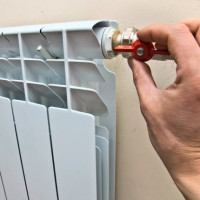 Aluminum heating radiators: overview of technical characteristics + installation principles
Aluminum heating radiators: overview of technical characteristics + installation principles  Vertical heating radiators: types + advantages and disadvantages + brand overview
Vertical heating radiators: types + advantages and disadvantages + brand overview 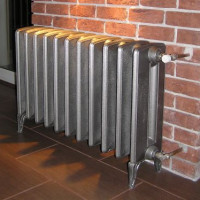 Cast-iron radiators: characteristics of batteries, their advantages and disadvantages
Cast-iron radiators: characteristics of batteries, their advantages and disadvantages 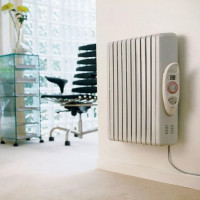 Electric heating radiators: the main types, advantages and disadvantages of batteries
Electric heating radiators: the main types, advantages and disadvantages of batteries 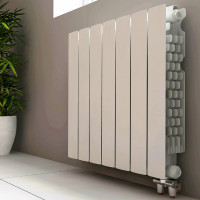 Steel heating radiators: varieties, characteristics and advantages of batteries
Steel heating radiators: varieties, characteristics and advantages of batteries  How much does it cost to connect gas to a private house: the price of organizing gas supply
How much does it cost to connect gas to a private house: the price of organizing gas supply  The best washing machines with dryer: model rating and customer tips
The best washing machines with dryer: model rating and customer tips  What is the color temperature of light and the nuances of choosing the temperature of the lamps to suit your needs
What is the color temperature of light and the nuances of choosing the temperature of the lamps to suit your needs  Replacement of a geyser in an apartment: replacement paperwork + basic norms and requirements
Replacement of a geyser in an apartment: replacement paperwork + basic norms and requirements
I saw such skirting boards from a friend in France. Honestly, their winter cannot be compared with ours, but it seemed cold to me anyway in the apartment. They are really thrifty all to the point of horror, so they probably include two or two hours a day. I don’t understand, by the way, it is regulated by the set temperature or can I turn on the heating myself? In Europe, they are used to the fact that 20 degrees is the optimum temperature, and for me it is so cold. But the advantages are still great - for country houses, where it helps to fight the humidity of the walls, but in this vein, I liked the idea.
As far as I understand, there is an opportunity to regulate the temperature, the adjustment is made as on conventional radiators using a thermostat. To do this, install the shut-off and control valve on the supply or return line. This is if a liquid thermal baseboard. With electric, I think, and so everything is clear - there is a thermostat on which you can manually set the desired temperature.
I would like to take this opportunity to thank the creators of the “warm skirting” heating system and inform readers about its high efficiency in the process of heating buildings in the winter. After all, that warm layer that forms between the wall and the air in your room really protects against cooling and allows heat to remain inside the room. Honestly, I am very glad that I succumbed to the persuasion of my wife and agreed to install this heating system instead of the classic one. In addition to being easy to install, it is also quite economical. And this allows us to save when paying for heating our home.